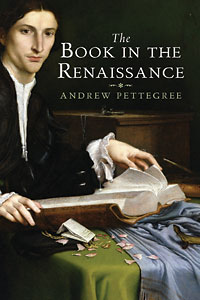Renaissance Readers
A new book examines how post-Gutenberg publishers and readers shaped early modern culture By Jeremy Dibbell Jeremy Dibbell is an assistant reference librarian at the Massachusetts Historical Society in Boston. An earlier version of this review appeared on the author’s blog, PhiloBiblos.blogspot.com.
The Book in the Renaissance
Andrew Pettegree;
Yale University Press;
421 pages;
69 b/w illustrations;
hardcover; $40
Buy it Now
Andrew Pettegree’s The Book in the Renaissance (Yale University Press) examines the first 150 years of print culture in Europe, surveying its origins, its spread, its characters, and its impact on the western world. Straight away he makes the key point, that early print culture was shaped “less by the idealism of scholars than by pragmatic businessmen for whom the only books that mattered were those that turned a profit,” and these weren’t (for the most part) the great folio tomes we know and love, but cheap, short, disposable pieces of news, controversial literature, popular science, and medicine.
Many of these productions, which Pettegree correctly describes as the bedrock of the nascent printing industry, have failed to survive at all, or if they do, it’s in a strikingly small number of copies (his example, on page 333, that of all the sixteenth-century books published in French more than half are known from only a single copy, was certainly enough to raise my eyebrows). Using the new technologies now available to us, Pettegree suggests that we can, “for the first time chart a coherent narrative of print, from the first experiments of the 1450s to the dawn of a mass information society.”
Pettegree’s opening chapters describe the early trials and tribulations of the printing trade, as processes of coordination were developed and commercialization schemes were launched (it became immediately clear, he notes, that jobbing work was going to be an absolute necessity when printing large projects, since the capital outlay for materials had to be made long before profits from book sales could be expected). He then chronicles the not-always-positive reaction to printing’s spread, as readers adapted to the new medium and printers sought niches within which they might operate successfully. A survey of print networks follows, as Pettegree uses several case studies to chart the geographic connections between authors, printers, booksellers, collectors, and others connected with the book world.
Pettegree’s examples encompass a wide range of personalities, from Aldus Manutius and Nicolas Jenson with their groundbreaking typographical and publishing strategies, to Erasmus (“almost certainly the first living author to make a substantial living from writing,” whose intimate involvement with the production process of his books was fascinating to learn of) to Martin Luther.
Given the author’s personal research interests and previous works, it’s not too much of a surprise that much of the book focuses on the Reformation’s impact on the book world and print culture. While there are chapters centered around literary publications, news-sheets, schoolbooks, and other genres (medical works, emblem books, &c.), these (though good) didn’t feel as strong as Pettegree’s treatment of the religious conflict that engulfed Europe and played a major role in shaping certain aspects of the book world during the sixteenth century. The struggle led to the first decisive steps toward censorship, geographic shifts in printing centers, and disruptions of the international book market.
As is usually the case with Yale University Press books, the high quality of the physical book complements the author’s text. The jacket is illustrated with a beautiful reproduction of Lorenzo Lotto’s Portrait of a Gentleman in his Study, and the many in-text images and maps are both well-reproduced and integrated nicely into the text. Additionally, the book has both full citation notes and a complete bibliography, which is as it should be.
For those with even a passing interest in book history, The Book in the Renaissance is essential. Like the Universal Short Title Catalogue project Pettegree directs as head of the School of History at the University of St. Andrews in Scotland, this fascinating and readable work deserves wide notice.








